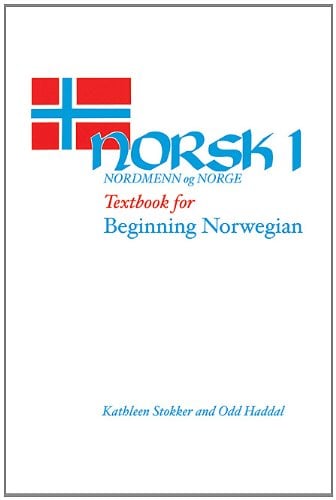Today I will be writing about Norsk – nordmenn og Norge: Textbook for Beginning Norwegian. The first thing I ever heard about this textbook was that it was “possibly the best book for learning languages ever made”. While I personally wouldn't consider this a candidate for “best language book ever”, I will say that it is definitely an amazing book, and the most thorough resource for learning Norwegian that I have ever encountered.
Before delving into the content of the book, I think a few disclaimers need to be made. First of all, this book came out over thirty years ago. I don't think that this is so long as to make the language in this book completely obsolete, but there are probably many examples which your average Norwegian speaker might find a little outdated. Not only that, but because of its age, the book is missing out on topics such as modern technology, cellular phones, and the internet. Secondly, this book is completely dedicated to teaching bokmål. This is not really a problem, as it is the standard form usually taught to foreign learners of Norwegian, but I think it would have also been interesting/useful if learners were introduced to nynorsk as well as some of the other dialects of Norwegian, if only for the sake of exposure. Finally, there are three separate components to this course: the main textbook, a supplementary workbook, and the audio recordings. I would highly recommend acquiring all three of these resources for any student before starting.
When I opened this book and flipped through the pages, the first thing I noticed was that there is very little English used. From the first lesson all of the section headers and instructions are written in Norwegian, which I found somewhat odd, given that this is a book written for absolute beginners. I think this is a clear indication that most students will likely be heavily reliant on the guidance of their instructor(s) in order to make good use of this book.
There isn't really a consistent format that the book follows, but the general pattern seems to be:
Dialogue(s)/Narrative(s) Questions and/or Exercises Vocabulary
As the lessons progress, both the length and quantity of the dialogues/narratives increases, up to the point where, at the end of the book, the student will reach stories spanning multiple pages. The book does not provide much in the way of guidance as far as how each lesson should be approached, so it will be up to the users of the book to decide the best way to attack each lesson. The vocabulary section at the end of each lesson does not appear to be entirely comprehensive, and the words are given only in Norwegian, organized alphabetically (mostly), by part of speech. I don't really get the point of listing the vocabulary like this, as it seems fairly useless without including the English definitions. The real problem is that, not only is the vocabulary not given in English, but there are no English translations of any of the content of the book, which means that someone (either the students or instructor) is going to have to put in a lot of extra work to create vocabulary lists. There is a glossary at the end of the book, so I don't think that this is too detrimental, just somewhat strange. While I believe that creating their own vocabulary lists can serve to benefit the students, it could have saved a lot of time if they didn't have to look up the words one by one.

I have mixed feelings in regard to how this course has approached teaching grammar. The main lessons of the textbook are practically devoid of any grammar explanations, aside from the occasional chart or rare footnote. If you use the workbook, there is a section that covers grammar for each lesson, but it is essentially covering general topics as you progress, rather than giving a comprehensive overview of all the grammatical features that are used in any particular lesson. There is a reference grammar at the back of the main textbook which students can use to look up anything they are curious about, but this is organized thematically, not according to the contents of the lessons. In other words, instructors using this course are going to have to specifically identify which sections students should review each lesson or just leave it up to students to look up anything they are curious about. Again, not a huge problem, but will require some extra effort on behalf of the users to work through the course.
I am fairly satisfied with the content of the workbook both in terms of the variety and scope of the exercises it provides. Although the grammar sections at the end of each lesson in the workbook are not by any means comprehensive, they are interesting, relevant, and easy to read. Answers to the exercises are included in the back of the book, along with transcripts of all audio sections. My biggest complaints about the workbook are that the font isn't very visually appealing, there is a lot of wasted space (blank pages, large empty spaces), and there are a lot of crossword puzzle exercises, which I do not consider legitimate exercises for language study. Those are relatively small issues though, and I think most students will not find them too distracting.
The audio recordings for this book can be conveniently purchased in electronic format online at the publisher's website (uwpress.wisc.edu) for $10, which is a pretty good deal. I think the audio recordings are perfect in terms of quality and content, but the way they are packaged is rather inconvenient. There is only one audio file for each lesson, which means that the audio files are, on average, between 15 and 30 minutes long. This is not ideal, because it means that if there is one particular section you would like to practice, you are going to have scan through a really long file to find the part you want, and you cannot conveniently rewind to the beginning of that exercise. The best way to fix this problem would be to use audio processing software to split each audio file into several separate files for each dialogue and exercise, or to mark the times where each section starts and ends. While this is a lot of extra work, I think it's an absolute necessity for any instructor planning on using this course, because otherwise you are going to have a lot of frustrated students on your hands.
"The amount of exposure students will get if they work through this entire course will put them at a level of proficiency much higher than that most any other language book for beginners."
I think a good way to describe the main textbook for this course is that it has one main strength and one main weakness. Its main strength is the amount of content. I don't think I have ever seen another introductory language text with such a large amount of dialogues, narratives, and information. The amount of exposure students will get if they work through this entire course will put them at a level of proficiency much higher than that most any other language book for beginners. Not only thematically, but also in terms of vocabulary and grammar, students using this book will be getting a lot more content than what is provided in a typical introductory course.
The main weakness of this course, on the other hand, is the almost complete lack of direction. Like I said, there is virtually no English written in the book (aside from the reference grammar), which means students either have no instructions, or instructions written only in Norwegian. In other words, your average student is not going to know what to do with this book if they just open it and start from page one. This can be mitigated with the help of a good instructor, but it means that more classroom time is going to be spent on teaching students how to use the book, instead of teaching them actual language. It is clear that the authors intended to maximize the amount of Norwegian used in the course, but some students are likely to find that the lack of English instructions makes the course frustrating and/or overwhelming.
When it comes down to it, I would have to say that I am still very impressed with this book. Despite its flaws, one cannot deny the amazing amount of content that it delivers in one compact course. I would highly recommend it for beginning Norwegian learners with the caveat that it is going to take some special effort to take full advantage of the content.



